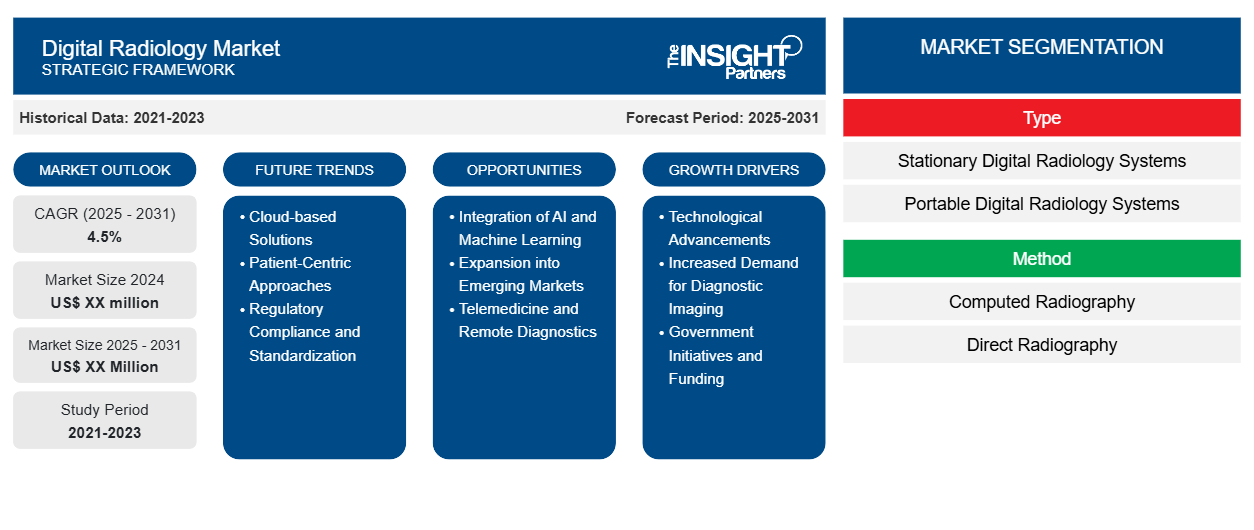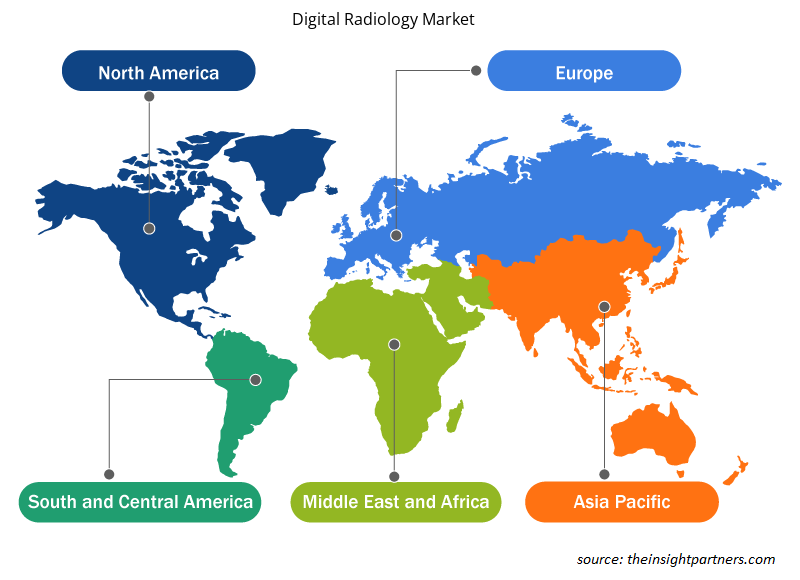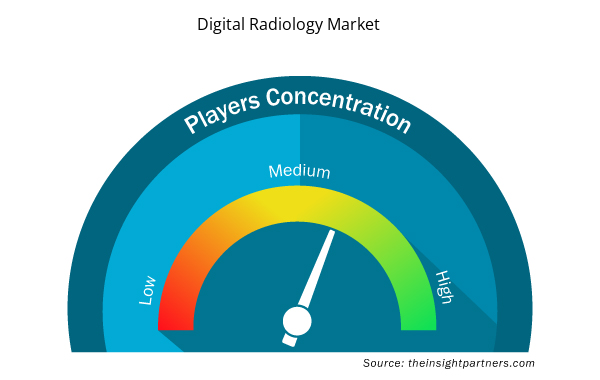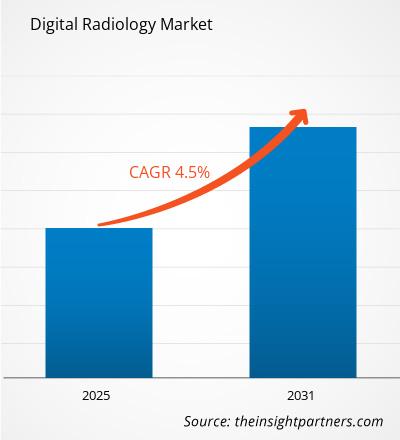Le marché de la radiologie numérique devrait enregistrer un TCAC de 4,5 % de 2025 à 2031, avec une taille de marché passant de XX millions USD en 2024 à XX millions USD d'ici 2031.
Le rapport est segmenté par type (systèmes de radiologie numérique fixes, systèmes de radiologie numérique portables). Il présente également une analyse basée sur la méthode (radiographie informatisée (CR), radiographie directe (RD)). Il est segmenté par application (imagerie cardiovasculaire, imagerie thoracique, imagerie dentaire, mammographie, imagerie orthopédique, autres) et par utilisateur final (hôpitaux et cliniques, centres de diagnostic, autres). L'analyse globale est ensuite ventilée par région et par principaux pays. Le rapport présente la valeur en USD pour l'analyse et les segments ci-dessus.
Objet du rapport
Le rapport « Marché de la radiologie numérique » de The Insight Partners vise à décrire le paysage actuel et la croissance future, les principaux moteurs, les défis et les opportunités. Il fournira des informations aux différents acteurs du secteur, notamment :
- Fournisseurs/fabricants de technologies : pour comprendre l’évolution de la dynamique du marché et connaître les opportunités de croissance potentielles, leur permettant de prendre des décisions stratégiques éclairées.
- Investisseurs : réaliser une analyse complète des tendances concernant le taux de croissance du marché, les projections financières du marché et les opportunités qui existent tout au long de la chaîne de valeur.
- Organismes de réglementation : Réglementer les politiques et les activités de police sur le marché dans le but de minimiser les abus, de préserver la confiance des investisseurs et de maintenir l’intégrité et la stabilité du marché.
Segmentation du marché de la radiologie numérique
Taper
- Systèmes de radiologie numérique stationnaires
- Systèmes de radiologie numérique portables
Méthode
- radiographie informatisée
- Radiographie directe
Application
- Imagerie cardiovasculaire
- Imagerie thoracique
- Imagerie dentaire
- Imagerie mammographique
- Imagerie orthopédique
- Autres
Utilisateur final
- Hôpitaux et cliniques
- Centres de diagnostic
- Autres
Personnalisez ce rapport en fonction de vos besoins
Vous bénéficierez d'une personnalisation gratuite de n'importe quel rapport, y compris des parties de ce rapport, ou d'une analyse au niveau des pays, d'un pack de données Excel, ainsi que de superbes offres et réductions pour les start-ups et les universités.
Marché de la radiologie numérique : perspectives stratégiques

- Obtenez les principales tendances clés du marché de ce rapport.Cet échantillon GRATUIT comprendra une analyse de données, allant des tendances du marché aux estimations et prévisions.
Facteurs de croissance du marché de la radiologie numérique
- Progrès technologiques : La radiologie numérique est principalement portée par des avancées technologiques rapides. Les technologies d'imagerie avancées, telles que la radiographie informatisée (CR) et la radiographie numérique (RD), ont amélioré la qualité des images et, par conséquent, la capacité diagnostique. Elles permettent également de gagner un temps considérable dans l'acquisition et le traitement des images, offrant aux professionnels de santé une alternative actualisée et éclairée. Les progrès de l'IA et du ML améliorent également l'analyse d'images, permettant de détecter des pathologies qui passeraient inaperçues à l'œil nu. Ces technologies progressent continuellement et leur mise en œuvre crée une demande croissante de solutions numériques en radiologie.
- Demande croissante en imagerie diagnostique : Ces dernières années, le diagnostic, notamment du cancer, des maladies cardiovasculaires et des affections orthopédiques, a connu une croissance fulgurante. Avec le vieillissement de la population mondiale, un diagnostic précoce et un traitement adapté de ces pathologies sont nécessaires. C'est pourquoi les méthodes diagnostiques non invasives de la radiologie numérique ont accru la demande dans les hôpitaux et les cliniques pour diagnostiquer ces maladies. Par ailleurs, la prévention prend désormais une importance croissante ; les prestataires de soins de santé recherchent donc des solutions d'imagerie numérique permettant une détection précoce des maladies.
- Initiatives et financements gouvernementaux : Les gouvernements du monde entier sont conscients qu’un meilleur accès aux outils de diagnostic avancés les aidera à surmonter les effets néfastes sur la santé. Certains pays ont déjà commencé à mettre en œuvre des programmes et des politiques de financement favorisant l’adoption des technologies de radiologie numérique. Par exemple, les investissements dans les infrastructures de santé, par le biais de réformes, sont une tendance courante, et des investissements sont également réalisés dans les solutions d’imagerie numérique. L’accès à une imagerie diagnostique de qualité augmentera non seulement le nombre d’établissements proposant des systèmes numériques, mais encouragera également les établissements de santé à les mettre à niveau.
Tendances futures du marché de la radiologie numérique
- Solutions cloud : Les solutions cloud sont de plus en plus utilisées en radiologie numérique. Les différentes configurations technologiques offrent des avantages tels qu'un stockage amélioré des données, une meilleure communication entre les professionnels de santé et l'accès aux dossiers des patients. Les radiologues numériques peuvent récupérer les images et les données où qu'ils soient, car elles sont stockées dans le cloud. Cela les aide à fournir des deuxièmes avis lors de consultations à distance. Ainsi, cette évolution favorise non seulement l'efficacité des flux de travail, mais permet également de réduire les coûts élevés liés à l'infrastructure informatique sur site des établissements de santé.
- Approches centrées sur le patient : Cette tendance se manifeste dans tous les services de santé, y compris en radiologie numérique. Elle accentue la pression sur le besoin de transparence et le droit des individus à accéder aux informations médicales, ce qui accroît la demande d'une plus grande implication des patients dans leurs décisions. Les solutions de radiologie numérique qui facilitent l'accès des patients aux résultats d'imagerie et facilitent la communication avec les professionnels de santé gagnent du terrain. Cette tendance témoigne de l'éducation et de l'engagement des patients dans chaque service de santé.
- Conformité réglementaire et normalisation : L'utilisation de la radiologie numérique est de plus en plus exigeante en termes de conformité réglementaire et de normalisation. Face à l'ampleur considérable de la production de données par les technologies d'imagerie, les organismes de réglementation soulignent la nécessité de protocoles standardisés pour garantir la sécurité et l'efficacité des pratiques d'imagerie. Des réglementations telles que la loi américaine sur la portabilité et la responsabilité en matière d'assurance maladie (Health Insurance Portability and Accountability Act), ou des réglementations similaires dans d'autres régions du monde, constituent des obstacles réglementaires majeurs pour les solutions numériques en radiologie. Les entreprises qui privilégient la conformité ou respectent les normes du secteur consolideront leur réputation d'acteurs solides et fiables sur le marché.
Opportunités du marché de la radiologie numérique
- Intégration de l'IA et de l'apprentissage automatique : La radiologie numérique ouvrira de vastes perspectives de croissance sur le marché grâce à l'intégration de l'intelligence artificielle et de l'apprentissage automatique. Cela pourrait améliorer l'interprétation, optimiser les flux de travail et réduire les erreurs humaines. Cela va jusqu'à l'automatisation des tâches routinières, où les radiologues consacreraient plus de temps aux évaluations complexes. Cela se traduira par une amélioration des soins aux patients. Les entreprises qui développent des solutions d'interprétation et de diagnostic d'images basées sur l'IA disposent d'une mine d'or à exploiter grâce à cette tendance, en fournissant un outil qui aidera les radiologues à établir le diagnostic le plus précis possible en un temps record.
- Expansion sur les marchés émergents : Un marché émergent représente également une opportunité de croissance pour la radiologie numérique. L'amélioration des infrastructures de santé en Asie, en Afrique et en Amérique latine entraînera une augmentation de la demande en solutions d'imagerie diagnostique avancées. Les investissements devraient être fructueux, car les établissements de santé chercheront à adopter des technologies modernes pour améliorer leurs capacités diagnostiques. De même, les entreprises qui proposent ces services adaptent leurs produits aux besoins spécifiques de leurs marchés, notamment en termes d'accessibilité et de convivialité.
- Télémédecine et diagnostics à distance : La télémédecine et les autres diagnostics à distance ont déjà commencé à transformer la prestation de soins de santé. La radiologie numérique s'est imposée comme un élément essentiel de cette transformation, car elle permet un échange efficace et rapide d'images et de comptes rendus entre les prestataires. Les services de télésanté connaissent une expansion considérable, tout comme les vastes possibilités offertes par les solutions de radiologie numérique, permettant d'obtenir des deuxièmes avis et des consultations avec plusieurs spécialistes à distance, depuis n'importe quel endroit, ce qui ouvre encore davantage de possibilités en matière de soins de santé. À mesure que les systèmes de santé s'adaptent à des modèles de soins de plus en plus décentralisés, le marché des entreprises développant des plateformes facilitant l'intégration complète de l'imagerie numérique à la télémédecine va croître.
Aperçu régional du marché de la radiologie numérique
Les analystes d'Insight Partners ont analysé en détail les tendances et les facteurs régionaux influençant le marché de la radiologie numérique tout au long de la période de prévision. Cette section aborde également les segments et la répartition géographique du marché de la radiologie numérique en Amérique du Nord, en Europe, en Asie-Pacifique, au Moyen-Orient et en Afrique, ainsi qu'en Amérique du Sud et en Amérique centrale.

- Obtenez les données régionales spécifiques au marché de la radiologie numérique
Portée du rapport sur le marché de la radiologie numérique
| Attribut de rapport | Détails |
|---|---|
| Taille du marché en 2024 | XX millions de dollars américains |
| Taille du marché d'ici 2031 | XX millions de dollars américains |
| TCAC mondial (2025 - 2031) | 4,5% |
| Données historiques | 2021-2023 |
| Période de prévision | 2025-2031 |
| Segments couverts | Par type
|
| Régions et pays couverts | Amérique du Nord
|
| Leaders du marché et profils d'entreprises clés |
|
Densité des acteurs du marché de la radiologie numérique : comprendre son impact sur la dynamique commerciale
Le marché de la radiologie numérique connaît une croissance rapide, portée par une demande croissante des utilisateurs finaux, due à des facteurs tels que l'évolution des préférences des consommateurs, les avancées technologiques et une meilleure connaissance des avantages du produit. Face à cette demande croissante, les entreprises élargissent leur offre, innovent pour répondre aux besoins des consommateurs et capitalisent sur les nouvelles tendances, ce qui alimente la croissance du marché.
La densité des acteurs du marché désigne la répartition des entreprises opérant sur un marché ou un secteur particulier. Elle indique le nombre de concurrents (acteurs) présents sur un marché donné par rapport à sa taille ou à sa valeur marchande totale.
Les principales entreprises opérant sur le marché de la radiologie numérique sont :
- Groupe Agfa-Gevaert,
- Canon Inc,
- Carestream Santé Inc,
- Société de portefeuille Fujifilm,
- Hologic, Inc.
Avertissement : Les entreprises répertoriées ci-dessus ne sont pas classées dans un ordre particulier.

- Obtenez un aperçu des principaux acteurs du marché de la radiologie numérique
Principaux arguments de vente
- Couverture complète : Le rapport couvre de manière exhaustive l’analyse des produits, des services, des types et des utilisateurs finaux du marché de la radiologie numérique, offrant un paysage holistique.
- Analyse d’experts : Le rapport est compilé sur la base d’une compréhension approfondie des experts et analystes du secteur.
- Informations à jour : Le rapport garantit la pertinence commerciale en raison de sa couverture des informations récentes et des tendances des données.
- Options de personnalisation : ce rapport peut être personnalisé pour répondre aux exigences spécifiques des clients et s'adapter de manière appropriée aux stratégies commerciales.
Le rapport de recherche sur le marché de la radiologie numérique peut donc contribuer à éclairer et à comprendre le contexte et les perspectives de croissance du secteur. Malgré quelques inquiétudes légitimes, les avantages globaux de ce rapport l'emportent généralement sur ses inconvénients.
- Analyse historique (2 ans), année de base, prévision (7 ans) avec TCAC
- Analyse PEST et SWO
- Taille du marché Valeur / Volume - Mondial, Régional, Pays
- Industrie et paysage concurrentiel
- Ensemble de données Excel



Report Coverage
Revenue forecast, Company Analysis, Industry landscape, Growth factors, and Trends

Segment Covered
This text is related
to segments covered.

Regional Scope
North America, Europe, Asia Pacific, Middle East & Africa, South & Central America

Country Scope
This text is related
to country scope.
Questions fréquemment posées
The Digital Radiology Market is estimated to witness a CAGR of 4.5% from 2023 to 2031
The major factors driving the Digital Radiology market are:
1. Technological Advancements
2. Increased Demand for Diagnostic Imaging
Integration of AI and Machine Learning act as a opportunity for growth of the market in forecast period.
North America region dominated the Digital Radiology market in 2023.
Stationary Digital Radiology Systems segment, by type, dominated the market in 2023.
Players operating in the market are Agfa-Gevaert Group, Canon Inc, Carestream Health Inc, Fujifilm Holdings Corporation, Hologic, Inc., Koninklijke Philips N.V., Protec GmbH & Co. KG, Shimadzu Corporation, Siemens, and Varian Medical Systems Inc
Trends and growth analysis reports related to Life Sciences : READ MORE..
1. Agfa-Gevaert Group,
2. Canon Inc,
3. Carestream Health Inc,
4. Fujifilm Holdings Corporation,
5. Hologic, Inc.
6. Koninklijke Philips N.V.,
7. Protec GmbH & Co. KG
8. Shimadzu Corporation
9. Siemens
10. Varian Medical Systems, Inc,
The Insight Partners performs research in 4 major stages: Data Collection & Secondary Research, Primary Research, Data Analysis and Data Triangulation & Final Review.
- Data Collection and Secondary Research:
As a market research and consulting firm operating from a decade, we have published and advised several client across the globe. First step for any study will start with an assessment of currently available data and insights from existing reports. Further, historical and current market information is collected from Investor Presentations, Annual Reports, SEC Filings, etc., and other information related to company’s performance and market positioning are gathered from Paid Databases (Factiva, Hoovers, and Reuters) and various other publications available in public domain.
Several associations trade associates, technical forums, institutes, societies and organization are accessed to gain technical as well as market related insights through their publications such as research papers, blogs and press releases related to the studies are referred to get cues about the market. Further, white papers, journals, magazines, and other news articles published in last 3 years are scrutinized and analyzed to understand the current market trends.
- Primary Research:
The primarily interview analysis comprise of data obtained from industry participants interview and answers to survey questions gathered by in-house primary team.
For primary research, interviews are conducted with industry experts/CEOs/Marketing Managers/VPs/Subject Matter Experts from both demand and supply side to get a 360-degree view of the market. The primary team conducts several interviews based on the complexity of the markets to understand the various market trends and dynamics which makes research more credible and precise.
A typical research interview fulfils the following functions:
- Provides first-hand information on the market size, market trends, growth trends, competitive landscape, and outlook
- Validates and strengthens in-house secondary research findings
- Develops the analysis team’s expertise and market understanding
Primary research involves email interactions and telephone interviews for each market, category, segment, and sub-segment across geographies. The participants who typically take part in such a process include, but are not limited to:
- Industry participants: VPs, business development managers, market intelligence managers and national sales managers
- Outside experts: Valuation experts, research analysts and key opinion leaders specializing in the electronics and semiconductor industry.
Below is the breakup of our primary respondents by company, designation, and region:

Once we receive the confirmation from primary research sources or primary respondents, we finalize the base year market estimation and forecast the data as per the macroeconomic and microeconomic factors assessed during data collection.
- Data Analysis:
Once data is validated through both secondary as well as primary respondents, we finalize the market estimations by hypothesis formulation and factor analysis at regional and country level.
- Macro-Economic Factor Analysis:
We analyse macroeconomic indicators such the gross domestic product (GDP), increase in the demand for goods and services across industries, technological advancement, regional economic growth, governmental policies, the influence of COVID-19, PEST analysis, and other aspects. This analysis aids in setting benchmarks for various nations/regions and approximating market splits. Additionally, the general trend of the aforementioned components aid in determining the market's development possibilities.
- Country Level Data:
Various factors that are especially aligned to the country are taken into account to determine the market size for a certain area and country, including the presence of vendors, such as headquarters and offices, the country's GDP, demand patterns, and industry growth. To comprehend the market dynamics for the nation, a number of growth variables, inhibitors, application areas, and current market trends are researched. The aforementioned elements aid in determining the country's overall market's growth potential.
- Company Profile:
The “Table of Contents” is formulated by listing and analyzing more than 25 - 30 companies operating in the market ecosystem across geographies. However, we profile only 10 companies as a standard practice in our syndicate reports. These 10 companies comprise leading, emerging, and regional players. Nonetheless, our analysis is not restricted to the 10 listed companies, we also analyze other companies present in the market to develop a holistic view and understand the prevailing trends. The “Company Profiles” section in the report covers key facts, business description, products & services, financial information, SWOT analysis, and key developments. The financial information presented is extracted from the annual reports and official documents of the publicly listed companies. Upon collecting the information for the sections of respective companies, we verify them via various primary sources and then compile the data in respective company profiles. The company level information helps us in deriving the base number as well as in forecasting the market size.
- Developing Base Number:
Aggregation of sales statistics (2020-2022) and macro-economic factor, and other secondary and primary research insights are utilized to arrive at base number and related market shares for 2022. The data gaps are identified in this step and relevant market data is analyzed, collected from paid primary interviews or databases. On finalizing the base year market size, forecasts are developed on the basis of macro-economic, industry and market growth factors and company level analysis.
- Data Triangulation and Final Review:
The market findings and base year market size calculations are validated from supply as well as demand side. Demand side validations are based on macro-economic factor analysis and benchmarks for respective regions and countries. In case of supply side validations, revenues of major companies are estimated (in case not available) based on industry benchmark, approximate number of employees, product portfolio, and primary interviews revenues are gathered. Further revenue from target product/service segment is assessed to avoid overshooting of market statistics. In case of heavy deviations between supply and demand side values, all thes steps are repeated to achieve synchronization.
We follow an iterative model, wherein we share our research findings with Subject Matter Experts (SME’s) and Key Opinion Leaders (KOLs) until consensus view of the market is not formulated – this model negates any drastic deviation in the opinions of experts. Only validated and universally acceptable research findings are quoted in our reports.
We have important check points that we use to validate our research findings – which we call – data triangulation, where we validate the information, we generate from secondary sources with primary interviews and then we re-validate with our internal data bases and Subject matter experts. This comprehensive model enables us to deliver high quality, reliable data in shortest possible time.

 Obtenez un échantillon gratuit pour ce rapport
Obtenez un échantillon gratuit pour ce rapport